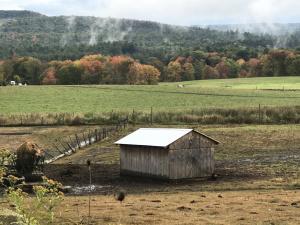 Following the very welcome enthusiastic reception for my Autumn Sofa Spotlight last week, today I’m delighted to be hosting one of the authors included there – American short story writer Linda Mannheim. Every year I come across one or two story collections which leave me reeling at what can be accomplished in the space of a few pages; this year Linda’s new release, This Way to Departures, (published by small independent Influx Press) is one of them and it only took me a few pages to sense that.
Following the very welcome enthusiastic reception for my Autumn Sofa Spotlight last week, today I’m delighted to be hosting one of the authors included there – American short story writer Linda Mannheim. Every year I come across one or two story collections which leave me reeling at what can be accomplished in the space of a few pages; this year Linda’s new release, This Way to Departures, (published by small independent Influx Press) is one of them and it only took me a few pages to sense that.
Although her guest post is about just one of the eleven story settings, you could say this collection is the ultimate Writers on Location book. It is inherently about place, through people: as origin, destination, exile, home. These stories are bound with notions of identity and often, tension and dislocation. I loved the emotional pull of the pared-back writing, the unsaid because it doesn’t need to be. They are universal even as they weave between several of the many communities which make up the USA, snapshots of American life and dreams stripped of cliché and intensely evocative of the later decades of the 20th century which already feel so long ago. And as if that doesn’t make it unique enough, today is the first ever Writers on Location post on a place known by a nickname, one given to many places around the world, as we discovered, but not the easiest to live up to, as Linda explains:
On paper, it was perfect: a New England town that looked like an illustration in a children’s book, a population of progressive people who were in some way connected to one of the nearby universities. Hannah, the narrator of ‘The Christmas Story’ – one of the stories from my collection – This Way to Departures — observes that:
Walking through the town at night, if I looked into all the lovely homes with their Christmas trees I could believe I’d spirited myself into the world I wanted to live in as a child. There are no fewer than five bookstores in this two street town.You once saw James Baldwin sitting at the window table at Judy’s. A free bus system takes the students from place to place, keeps their cars off the roads when they’re drinking. Almost every musician touring the northeast stops here. People call this – half-jokingly – the Happy Valley.

Of course Hannah discovers she is not happy in the Happy Valley. And neither was I.

I was still shaking off the adrenaline pumping episodes of my childhood home when I arrived in the Happy Valley, still considered unlocked front doors a novelty, still felt as if I’d made it there because of a successful escape. I was dazzled by the night sky when I drove my car down empty back roads at night. I was transfixed by the swirls of fireflies. In the winter, piles of snow were lit up in lavender when there was a full moon. And in summer, we’d pick one another up at our low-paying sweat-stained jobs and drive to one of the quiet swimming areas: Pleasant Pond or the potholes in Shelburne Falls.


I’m not like you, I started to think, when friends in the Happy Valley talked about how lucky and privileged we all were. And then I realised it was not possible to talk about how I wasn’t, to talk about the place I’d come from without encountering resistance. Surely I was exaggerating, one person responded. It wasn’t like that when I was growing up, was it? But I was from the nice part, wasn’t I?

Like Hannah, I found myself becoming very unhappy in the Happy Valley. And for a while, I thought the problem was me – I thought even in the Happy Valley, I couldn’t manage to be happy.
One day I drove down to the train station in Connecticut, parked my car, and returned to New York City for the first time in a long time. I arrived at Penn Station just in time for rush hour. On 34th Street there were business-suited baddies walking briskly, children panhandling because they been sent out, weary-looking workers rushing from one job to another. The air smelled like hot dogs, bus exhaust, hot cement. People shouted. Car horns hooted. And my heart pounded at the familiarity. A lost world returned to me. And I was happy.
Many thanks to Linda for this very personal and atmospheric piece – like the stories in her collection it conveys place in both physical and emotional dimensions and is a reminder that we all want different things of our lives and the places where we spend them.
Location photos © Lynley Rappaport with thanks
*POSTSCRIPT*
Next week you can look forward to another superb Writers on Location post from Helen Young on the setting of her debut novel Breakfast in Bogotá in the style of a travel guide.

